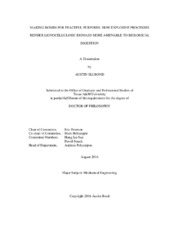| dc.description.abstract | Experiments were performed to investigate the effects of shock waves – generated by explosive processes – on enhancing enzymatic digestibility of corn stover for conversion into biofuels, chemicals, or animal feed. Following an alkaline chemical pretreatment process, shock treatment was performed, which increased digestibility. Digestibility was assessed at a standard enzyme loading of 46.7 mg protein/g glucan. Without shock, the enzymatic conversion was 0.80 g glucan digested/g glucan fed. With shock, the enzyme loading is reduced by ~2× while maintaining a constant conversion.
Shotgun shells and hydrogen detonation produced identical digestibility increases; however, hydrogen detonation eliminated the need to magnetically remove contaminants introduced from shotgun shells. Contrary to initial hypotheses, varying vessel geometry (depth = 1–3 ft, diameter = 4–8 in) or process conditions (peak pressure = 2.07–12.1 MPa, and solids concentration = 5–10%) had an insignificant impact on shock treatment efficacy within the experimental domain tested. Instead, the pressurization rate is the key parameter when scaling the shock treatment process. Specifically, the shotgun shell blast (108,000 MPa/s) and hydrogen detonation
(4,160,000 MPa/s) generate pressure quickly enough to enhance digestibility; in contrast, the propane deflagration (37.2 MPa/s) did not.
Therefore, process scaling is extremely simple, because a vessel that contains gas detonations should suffice. A slurry pump enables rapid cycling of the 20-L shock tube to already function at a commercially relevant scale. The maximum benefit of shock treatment has yet to be determined. Subsequent experiments performed with plasma discharge and solid explosives failed to increase digestibility, at the conditions employed; but, liquid-phase shock waves may be more effective. | en |


